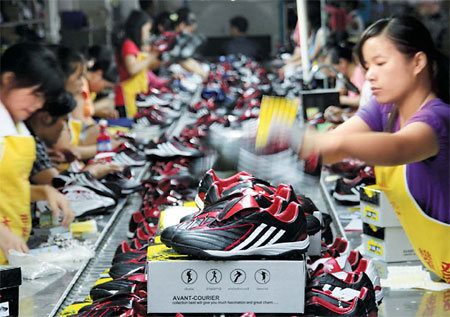
|
BIZCHINA> Top Biz News
 |
|
Related
Brand building key to shoemakers' success
By Tong Hao and Hu Meidong (China Daily)
Updated: 2008-12-22 07:55
 With a new NBA season, commercials of basketball super stars are heating up the media but some are not endorsing Nike or Adidas, but Chinese brands. Houston Rockets' stars Steve Francis and Shane Battier endorse Anta and Peak respectively. The two sports shoemaking companies located in Jinjiang, a southeast city in Fujian province, are thriving when many labor-intensive Chinese businesses are struggling in the international financial turmoil. Yang Yimin, a senior official of the local government, says: "Integrating an industrial chain and brand building are the two keys for Jinjiang shoe manufacturers to combat difficulties." During the first nine months of 2008, the shoe export value of Quanzhou, the administrative city of Jinjiang, was $1.8 billion and accounted for half of the shoe exports in Fujian and 8.35 percent of the country's total, according to Quanzhou inspection and quarantine bureau. The output of the shoe making industry in Quanzhou is expected to reach 63.82 billion yuan this year, occupying 60 percent of domestic market and 10 percent of the world market. Integration helps to improve the efficiency of the industrial chain and shelters small and medium-sized enterprises (SMEs) from shrinking overseas demand, Yang says. Currently, there are more than 3,000 shoe manufacturers and 2,000 related material suppliers in Quanzhou with 600,000 employees. Before the integration, repetition in research and development (R&D) and production were common within the industry. For example, manufacturers and material suppliers all plunged into development and production of shoe soles, which therefore reduced efficiency. Since the five-year integration project started in 2005, Jinjiang has roughly built a complete industrial chain with a clear labor division. Raw material suppliers, designers and manufacturers have integrated the industry into "one big enterprise", says Yang. SMEs in Jinjiang have particularly benefited from the smooth running industrial chain. "The enterprises willing to provide original equipment manufacturer manufacturing for local enterprises with self-brands are less likely to go bankrupt," says Yang. Currently, there are five OEM manufacturers for 361 (China) Co Ltd, a local sports product enterprise. Some other SMEs serve as workshops for large manufacturers through equity participation. "OEM manufacturers for Anta and Peak are all running well despite the financial crisis," says a spokesman for the Jinjiang Footwear Association. The other key factor is brand building. There are 107 State-level brands in Jinjiang, the taxation of which has increased by 41.9 percent during the first three quarters. More than 230,000 retail outlets carrying Jinjiang brands are scattering nationwide. Peak became the first Chinese sports brand to sponsor NBA games in 2005 and later contracted Battier and former New Jersey Nets and current Dallas Mavericks' star Jason Kidd as spokespeople. Huston Rockets players Luis Scola and Steve Francis also wear Anta shoes on the court. The 361 brand won the bid to become the exclusive clothing supplier for CCTV's central sports channel in 2009. The company is also the senior partner of the 2010 Asian Games in Guangzhou. Brand building brings obvious success. The growing rate of Peak in the Middle East and European market has exceeded 60 percent since the beginning of this year. "In addition to the high quality, our products are well received worldwide," says Wu Bingrui, director of Peak's international business department. Currently, Quanzhou shoes are exported to more than 80 countries and districts including European Union, the United States, Japan and the Middle East. The shoe making industry is not the only sector that has benefited from Jinjiang's integration and brand-building strategy. The output of textile, garment and leather making industries in Jinjiang all increased by over 20 percent from a year earlier in the first half this year. "Although Jinjiang is feeling the impact brought about by rising production costs and a shrinking overseas market, the economy is still developing stably," says Yang. Jinjiang's GDP has increased 14.6 percent year- on-year in the first half this year, 4.2 percent higher than the national average. The number of enterprises with a production value exceeding 100 million yuan has increased by 39 to 154 and the figure is expected to hit 300 at the end of this year. "Crisis and opportunities always coexist," says Yang. "Deterioration of our living environment is forcing Jinjiang enterprises to improve its development pattern, and the integration of our industrial chain and brand building has set a good example." (For more biz stories, please visit Industries)
|